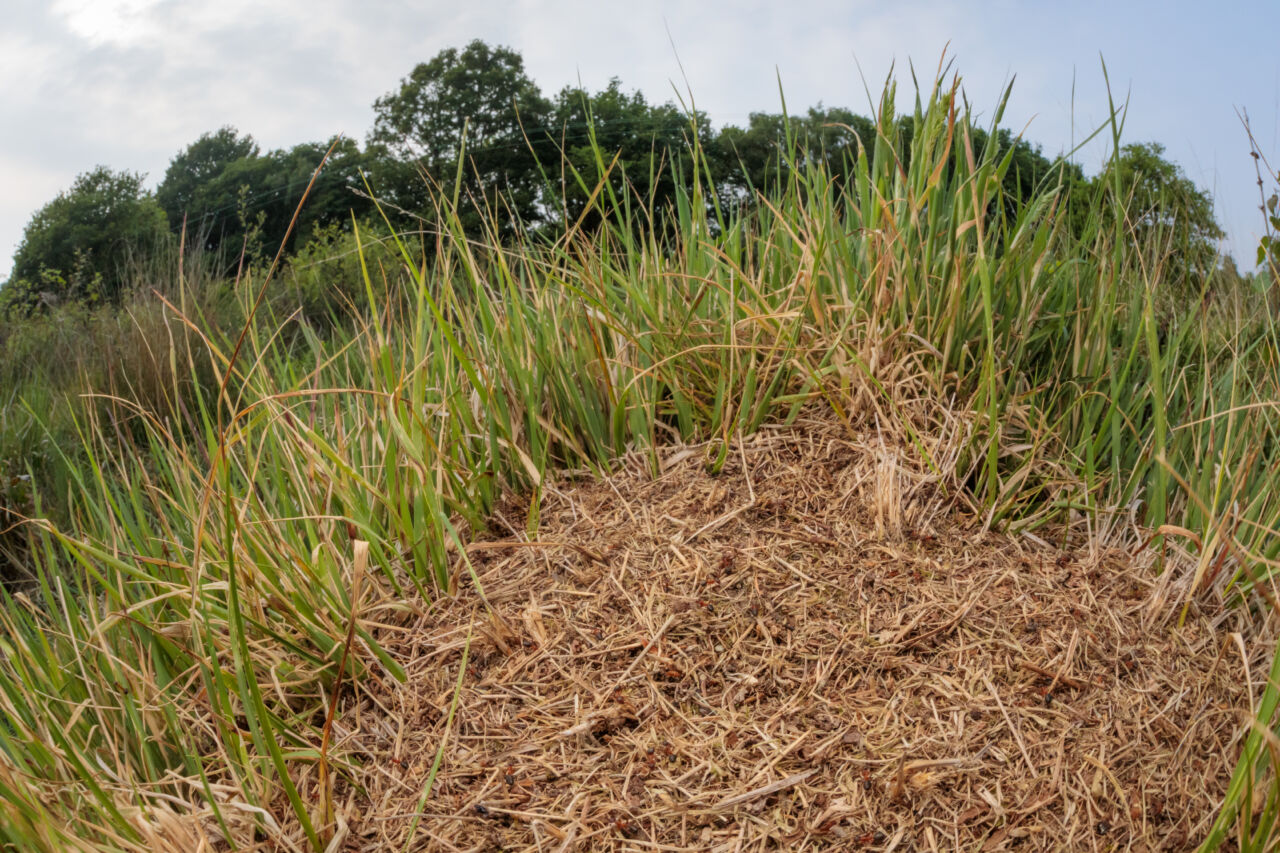An unexpected pollinator – The narrow-headed ant
Ants are not known for their pollination services. Nor do they necessarily perform them voluntarily. But sometimes they are indispensable.

Narrow-headed ants (Formica exsecta) feeding on a moth wing. South Devon, UK. May. Image: Flickr/Alex Hyde, CC license
Profile
- Formica exsecta, commonly known as the narrow-headed ant is widely distributed throughout Europe.
- It belongs to the family Formicidae, which includes over 12 000 species of ants.
- Its narrow head and long mandibles enable it to capture and carry prey.
- The ants are typically dark brown or black in color, and workers can range in size from 5 to 9 mm in length.
- The species is known for its aggressive behavior. When disturbed, it will swarm out and may bite vigorously, which can be stressful for both livestock and humans.
- It can be found in a variety of habitats, including forests, meadows, and alpine regions.
- Formica exsecta is currently listed as Least Concern on the IUCN Red List, although specific populations may be threatened by habitat loss and fragmentation.
Classification
- Kingdom
- Animalia
- Phylum
- Arthropoda
- Class
- Insecta
- Order
- Hymenoptera
- Family
- Formicidae
- Genus
- Formica
- Species
- F. exsecta
Life cycle
The narrow-headed ant is a social species with a complex life cycle that includes several distinct stages. The breeding biology follows similar patterns to other boreal* ant species.
Typically, the queen will start laying eggs in late spring after hibernation and mating. She produces a number of sexuals first that develop into queens and males, before laying eggs that develop into workers, which are regularly produced until autumn. Workers will usually hibernate only once, but some may survive to hibernate twice, while the queens can survive for many years. The workers take on various roles within the colony, including foraging, brood care, and defense. Depending on the location, colonies can be monogynous (only one egg-laying queen in the colony) or polygynous (many egg-laying queens in the colony), usually through the adoption of daughter queens or related queens.
Miners and builders
Nests of the narrow-headed ant can be found in a variety of locations, including under stones, in the ground, and in decaying wood. The species also creates large mounds out of leaf litter above ground that can be up to one meter in diameter. The nest structure consists of a series of chambers and tunnels created by the workers using their mandibles and bodies to excavate the substrate. The nests can be extensive, with multiple levels and chambers that provide shelter and protection for the colony. The material and shape of Formica exsecta nests can be variable, affected by soil type, surrounding vegetation and sun exposure. Typically, nests are composed of harvested grasses which are finely bitten, conifer needles, small leaves, parts of moss and herbs or earth and pebbles.

Nest of the Narrow-headed Ant (Formica exsecta). The thatch slopes to face south, maximizing heat absorption from the sun. Image: Flicker/Alex Hyde, CC license
Did you know?
The narrow-headed ant is known for its ability to form vast colony networks, with some of the largest systems in Europe consisting of thousands of nests dispersed over several hectares of land. The largest known nest network of Formica exsecta has been found in Romania. This colony network is estimated to consist of 3,350 individual nests dispersed over approximately 22 hectares of land. The network is thought to be composed of multiple related subcolonies that work together to share resources and defend their territory. The colony network of the narrow-headed ant serves as a fascinating example of the complex social behavior and organization that can be found in insect societies. The ability of Formica exsecta to form such vast colony networks is thought to be a key factor in their success as a species, allowing them to thrive in a variety of habitats and environments. Not many studies are available regarding the life expectancy of such nest systems but in a Finnish population studied in the Tvärminne archipelago, colonies lived a maximum of 30 years and contained on average 2 300 individuals.
Crucial attraction
Ants are not renowned for their pollinating services. In contrast, from the perspective of a plant, they are unwanted visitors since they help themselves to nectar without transferring any pollen and keeping real pollinators away due to their aggressive behavior. It came, therefore, as a surprise when only a few years ago scientists discovered that the narrow-headed ant acts as an important pollinator for the frog orchid (Dactylorhiza viridis), in a particular region in the Dolomites. This orchid is entirely green and quite inconspicuous. However, it has a unique pollination strategy, relying on beetles and ants to transfer pollen between flowers. This specialized pollination strategy is critical for the survival of the green-winged orchid, as flower's anatomy limit the pollination by the wind or other insects. The flowers of the frog orchid are arranged in a tight spiral, with the anther* and stigma* held close together, making it difficult for non-pollinating insects to access the floral resources and steal them.
Watch in this video an ant getting numerous pollen parcels (pollinaria) stuck on his forehead while feeding on an orchid and carrying them unintentionally around, thus contributing to the pollination of this orchid species.
To view this content, you must accept marketing and third-party cookies.
The association between Formica exsecta and the frog orchid highlights the complex and often intricate relationships that exist between insects and plants, and the important role that insects play in the pollination and reproduction of many plant species. The frog orchid is an important plant in the ecosystems where it is found. It provides habitat and food for a variety of insects, including bees and butterflies, and is also an indicator species for healthy grasslands and meadows.
*Glossary
Anther: Part of the flower where pollen is produced.
Boreal: Forests at high altitudes or in the northern parts of the world.
Stigma: Part of the flower where pollen germinates.
References
Claessens J. & Seifert B. 2017. Significant ant pollination in two orchid species in the Alps as adaptation to the climate of the alpine zone. Tuexenia. 37: 363-374.
Glaser F et al. 2010. Die Große Kerbameise Formica exsecta NYLANDER, 1846
(Hymenoptera, Formicidae). Verbreitung, Ökologie und Gefährdung des Insekts des Jahres 2011 in Österreich. Beiträge zur Entomofaunistik. 11: 107-119.
Martin SJ et al. 2009. Polygyny reduces rather than increases nestmate discrimination cue diversity in Formica exsecta ants. Insectes Sociaux. 56: 375-383.
Seifert B. 2007. Die Ameisen Mittel- und Nordeuropas. Lutra Verlags- und Vertriebsgesellschaft, Görlitz / Tauer, 367pp.
Pamilo, P., 1991. Life span of queens in the ant Formica exsecta. Insectes Sociaux, 38, pp.111-119.
Vitikainen, E.I., Haag-Liautard, C. and Sundström, L., 2015. Natal dispersal, mating patterns, and inbreeding in the ant Formica exsecta. The American Naturalist, 186(6), pp.716-727.
Sundström, L. and Vitikainen, E., 2022. The life history of Formica exsecta (Hymenoptera: Formicidae) from an ecological and evolutionary perspective. Myrmecological news, 32.
Wiezik, M., Gallay, I., Wieziková, A., Čiliak, M. and Dovciak, M., 2017. Spatial structure of traditional land organization allows long-term persistence of large Formica exsecta supercolony in actively managed agricultural landscape. Journal of insect conservation, 21, pp.257-266.
Marko, B., Czekes, Z., ERŐS, K., CSATA, E. and Szasz-Len, A.M., 2012. The largest polydomous system of Formica ants (Hymenoptera: Formicidae) in Europe discovered thus far in Romania. North-Western Journal of Zoology, 8(2).
